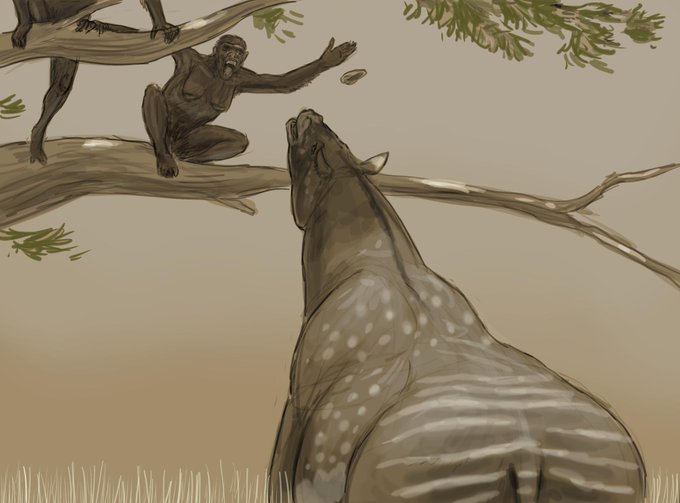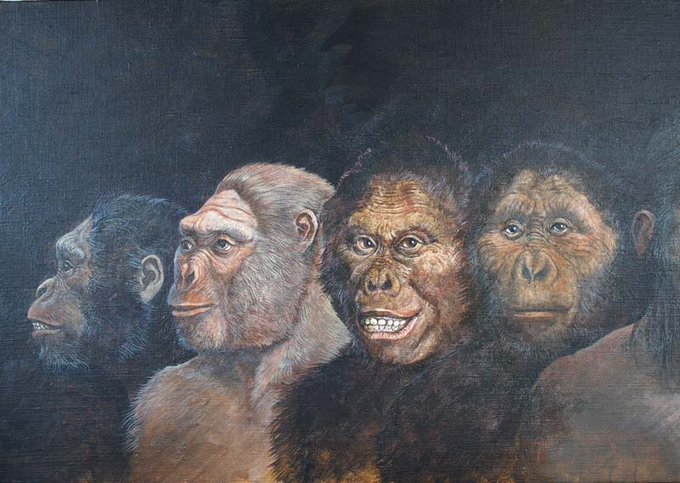australopithecusのTwitterイラスト検索結果。 58 件中 3ページ目
Stone tools.
Another illustration for the recently published biology schoolbook. A selection of artefacts of the Oldowan culture. A very early culture of simple pebble tools, it was practised by early species of Homo and late Australopithecus. Not fancy, but sharp and useful.
Australopithecus afarensis lived between 3.85 – 2.95 million years ago in Eastern Africa. More than 300 individuals of this species have been discovered across a span of about 900,000 years, which is more than 4 times as long as modern humans have been around.
A little Australopithecus portrait. Admittedly probably not very accurate anatomy, as I based it on a sketch I did 2 years ago. More of an exercise in rendering than a rigorous reconstruction.
The evolution of African and Eurasian Homo--whether H. erectus, H. antecessor, H. ergaster, or whatever species--came with foot anatomy and longer legs that set them apart from Australopithecus. We share this striding bipedalism today.
Australopithecus sediba Used Their Hands for Both Climbing and Human-Like Manipulation
https://t.co/iczz44kkpk
#paleoanthropology #anthropology #science
Une grotte d'Afrique du Sud a livré des crânes fossiles d'#Homo erectus et de #Paranthropus boisei qui sont les + vieux connus pour ces 2 espèces !
Il y a 2 Ma, ils cohabitaient en Afrique avec Australopithecus.
#Pléistocène #Hominidae #Homininae
Source : https://t.co/UXIbtPJ4zA
Lucy and Tembo, Australopithecus afarensis, by Michael Hagelberg #goodnight
Dos cráneos de Drimolen-Sudáfrica de 2 Ma: DNH 134 es el H erectus más antiguo, contemporáneo con Australopithecus sediba y Paranthropus robustus, al que corresponde el otro cráneo DNH 152. ¿Cuál es cuál? Al parántropo se le reconoce por su cresta sagital.
https://t.co/ozdItbIg4b
'Lucy' (Australopithecus afarensis) had an ape-like brain, but prolonged brain growth like humans
https://t.co/0GGgTcDwbI
Results from the #paleostream! More humans. Sahelanthropus, a Denisovan, Australopithecus sebida and a gay H. erectus couple.
#paleoart #hominins #africa #art #sketching #sciart
¡Presentado el primer cráneo casi completo (y primera cara) de Australopithecus anamensis! Encontrado en 2016 en Woranso-Mille, Etiopía. De ~3,8 Ma. ¿Coexistieron Au anamensis y su sucesora Au afarensis durante ~100.000 años? Haile-Selassie et al (2019) https://t.co/2zmqKsypND
Australopithecus Mothers Breastfed Their Infants for Year after Birth
https://t.co/VDOB8JtiSC
#anthropology #paleoanthropology #science
La cotidianidad de la vida en el pasado con Emily Schnall (@emily_schnall) https://t.co/2AqBe5joi7 #tarbosaurus #smilodon #daeodon #australopithecus #illustration
Human Evolution
Sahelanthoropus tchadensis, Ardipithecus ramidus, Australopithecus afarensis, Paranthropus boisei,
WIP of an australopithecus Sediba reconstruction #sciart #sediba @LeeRberger













































